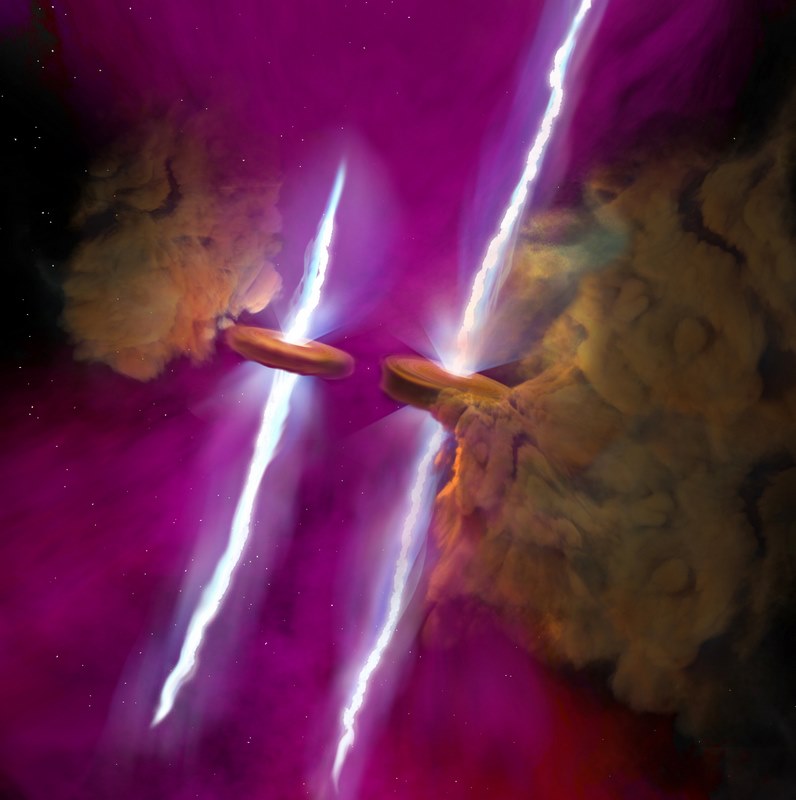 An artist's impression of star system WL20 – credit, U.S. NSF/ NSF NRAO/B. Saxton.; NASA/JPL-Caltech/Harvard-Smithsonian CfA
An artist's impression of star system WL20 – credit, U.S. NSF/ NSF NRAO/B. Saxton.; NASA/JPL-Caltech/Harvard-Smithsonian CfAAstronomers were thrilled when they received the news that they were expecting twins—stars that is, after their telescopes recorded dramatic jets erupting from a faraway star system.
To preface the thrilling discovery, most of the Universe is invisible to the human eye because the building blocks of stars are only revealed in wavelengths outside of the visible spectrum of light our eyes can perceive.
Astronomers recently used two very different, and very powerful telescopes to discover two separate disks pierced by jets erupting from two separate young stars in a binary star system. This discovery was unexpected, and unprecedented, given the age, size, and chemical makeup of the stars, disks, and jets. Their location in a known, well-studied part of the Universe adds to the thrill.
Observations from the U.S. National Science Foundation’s (NSF) National Radio Astronomy Observatory’s (NRAO) Atacama Large Millimeter/submillimeter Array (ALMA) and NASA’s James Webb Space Telescope’s (JWST) Mid-Infrared Instrument (MIRI) were combined for this research.
ALMA and JWST’s MIRI observe very different parts of the electromagnetic spectrum. Using them together allowed astronomers to discover these twins, hidden in radio and infrared wavelengths in star system WL20, located in the nearby rho Ophiuchi molecular cloud complex, over 400 light years away from the Earth.
“What we discovered was absolutely wild,” shares astronomer Mary Barsony. “We’ve known about star system WL20 for a long time. But what caught our attention is that one of the stars in the system appeared much younger than the rest. Using MIRI and ALMA together, we actually saw that this one star was two stars right next to each other.”
“Each of these stars was surrounded by a disk, and each disc was emitting jets parallel to the other,” she adds.
MORE STAR FORMING REGIONS: New James Webb Image Shows ‘Crowded, Tumultuous’ Heart of Our Galaxy in Never-Before-Seen Detail
ALMA spotted the discs, while MIRI found the jets. Co-author Valentin J.M. Le Gouellec of NASA retrieved and reduced ALMA archival data to reveal the discs’ composition, while Lukasz Tychoniec of Leiden Observatory provided high-resolution images, revealing the discs' massive size, approximately 100 times the distance between the Earth and the Sun.
“So if it weren’t for MIRI, we wouldn’t even know that these jets existed, which is amazing,” Barsony adds.
Another remarkable thing about this discovery is that it may never have had the opportunity to happen. JPL scientist Michael Ressler explains that when he had command of the JWST for a brief moment, he decided to reconnect with an old flame.
CHECK OUT THESE JETS: Black Hole Emits Jets of X-rays 60,000 Times Hotter than Sun–the Brightest Quasar Ever Observed
“A lot of the research about binary protostars focuses on a few nearby star-forming regions. I had been awarded some observing time of my own with JWST, and I chose to split it into a few small projects,” Ressler said.
“For one project, I decided to study binaries in the Perseus star-forming region. However, I had been studying WL20, which is in the rho Ophiuchus region in nearly the opposite part of the sky, for nearly 30 years, and I thought, ‘why not sneak it in? I’m never going to get another chance, even if it doesn’t quite fit with the others.’ We had a very fortunate accident with what we found, and the results are stunning.”
By combining multi-wavelength data from ALMA and JWST, these new findings shed light on the complex processes involved in the formation of multiple star systems.
Source link

